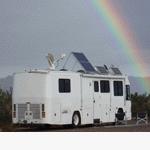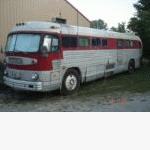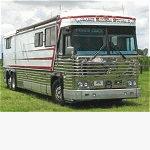| Author | Message | ||
| Bruce Henderson (Oonrahnjay)
Registered Member Username: Oonrahnjay Post Number: 622 Registered: 8-2004 Posted From: 70.60.102.56  Rating: N/A |
Is there a thermostat in a generator? I'm asking this because of the possibility of the generator not warming up enough if plumbed into the vehicle's radiator (and the bus engine not running/cold while parking). So, will a generator "over-cool" if plumbed into the vehicle's radiator and used when the engine is cold/not running? Is there any reason not to hook the generator cooling into the vehicle radiator/cooling system? Thanks, BH NC | ||
| Arthur N. Gaudet (Runcutter)
Registered Member Username: Runcutter Post Number: 38 Registered: 9-2006 Posted From: 70.122.250.111 Rating: N/A |
Bruce, we ran into trouble with our 4107 - set up the way you discuss. The 8V71 and generator are plumbed together, along with a heat exchanger in the water heater Water heater and generator are tied into the coach defroster line. It was set up that way by the previous owner, in the northeast. While working on the coach, we had the generator running (in Texas), but without the 8V71 running, no radiator fan. The generator diesel overheated, hose burst, and (I hope) a sensor shut down the generator diesel. We haven't tried the generator since, so I hope no damage was done (head gasket?), but it's possible. So, perhaps the opposite question would help you - what happens with that plumbing setup, and no air forced through the radiator? Arthur | ||
| Bruce Henderson (Oonrahnjay)
Registered Member Username: Oonrahnjay Post Number: 623 Registered: 8-2004 Posted From: 70.60.102.56  Rating: N/A |
Thank you, Arthur. I have a shaft off the engine, with a pulley on the end, turning the radiator fan via a couple of V-belts. Thus, no way to turn the fan without the engine running. This sounds like an important factor. (I don't think that there is a practical way to set up an electric "helper"/ alternative fan on the main radiator.) | ||
| Jim Blumenthal (Jimblu)
Registered Member Username: Jimblu Post Number: 23 Registered: 11-2008 Posted From: 208.168.233.87 Rating: N/A |
I did it that way for many years and many miles in the hottest of weather with no problems at all. I used an electric fan run by the generator on the radiator, and had separate inlet and outlet connections to the radiator top and bottom tanks. It saved a lot of space and was very quiet. The amount of heat added by the generator to the cooling system load is negligible. | ||
| Jim and Myrna Lawrence (Daffycanuck)
Registered Member Username: Daffycanuck Post Number: 72 Registered: 10-2004 Posted From: 66.82.9.62  Rating: N/A |
We run (and have for 12 years) our diesel generator setup that way as well. We have no fan and have never run into a heating problem. Another plus is that in cold weather, we start the generator and let it run to warm the 'big' engine. Works like a charm!! | ||
| George M. Todd (George_todd)
Registered Member Username: George_todd Post Number: 1143 Registered: 8-2006 Posted From: 99.103.159.139 Rating: N/A |
Bruce, Yes, there is a thermostat in all of the RV generators that I have seen. No, there is no reason that I know of to NOT hook a generator to the chassis cooling system. (There are a LOT of reasons TO hook up the generator this way, in my opinion.) Art's post is sad, too bad his previous owner didn't think first. We also don't know exactly what the actual coolant flow was thru the system? In other words, by hooking the gen into the defroster loop, did/does the gen's hot water actually flow thru the radiator, or just thru the DDs water pump??? I'm also surprised that there wasn't a hot engine alarm or shutdown on the generator in question. Maybe that is another omission by the PO? If you look at my comments on "Generator Musings," several posts below, you will see that I strongly suggest hooking up the gen and at least an exchange water heater up to the main cooling system. I do also specifically mention, as Jim does, a seperate electric fan to cool the radiator while boondocking. A question, what's on the side of your rad opposite the mechanical fan? Is there 2 inches of clearance between the core and the intake louvers, screen, or whatever? If so, there's room for an electric fan on the outside of the rad. Add a Webasto, a circ pump, some valves, and some baseboards, etc to the loop, and you have your entire heating system, and a quick block heater all in one. G | ||
| Tom Christman (Tchristman)
Registered Member Username: Tchristman Post Number: 266 Registered: 1-2006 Posted From: 66.218.33.156 Rating: N/A |
My method is to keep the two engines completely separated-including cooling systems. I have a remote mounted radiator for the generator that uses a two speed motor belt driven to a squirrel cage blower. On low, it hardly makes a sound. The main reason to keep them separate-if one of the engines fails in anyway that affects the cooling system-the other will also be affected. For instance, if you have a radiator hose go on a hot day on your big engine, your generator would also be incapacitated. On the other hand with the two radiators separated, in this instance, you'd still have the generator running keeping the inside of the bus cool while repairing the blown big engine radiator hose. Just my way-I like redundancy. Good Luck, TomC | ||
| FAST FRED (Fast_fred)
Registered Member Username: Fast_fred Post Number: 1364 Registered: 10-2006 Posted From: 66.82.9.81  Rating: N/A |
IF you like fancy , a marine HW heater can be in the cooling circuit , so no electric power is lost making HW. You might also consider a loop for baseboard heaters if you camp in Ski country. Pre heating the engine would probably be better with simple electric. FF | ||
| Luvrbus (Luvrbus)
Registered Member Username: Luvrbus Post Number: 973 Registered: 8-2006 Posted From: 74.33.54.135 Rating: N/A |
To each his own but I keep the 2 separate living where we have some 120 degree days the generators shutdown.It makes for a major cleanup if you lose a oil cooler and I have replaced a few of the small engines that were tied together some it may work for some it may not those little diesels are not cheap to rebuild good luck | ||
| Bruce Henderson (Oonrahnjay)
Registered Member Username: Oonrahnjay Post Number: 624 Registered: 8-2004 Posted From: 70.60.102.56  Rating: N/A |
Thanks for the good info and descriptions of your experiences. (FF - I have already bought an Atwwod LP/120/heat-x water heater [new, and already installed] and an "Aqua-Hot", which I got from Nick and which will be going in next week.) | ||
| Dallas Farnworth (Dallas)
Registered Member Username: Dallas Post Number: 147 Registered: 7-2004 Posted From: 75.91.207.168  Rating: |
Like Tom says... separate! I don't like the inverters with a built in charger or a Television with a built in VCR/DVD/DVR. Why? because when one piece quits, the rest might as well be trashed, especially with inverters. Since Xantrex has been trying to corner the market via buying Heart, Trace, and a myriad of others, they have discontinued service of not only those models, but also their own. If a system can't stand alone, you have another failure point that WILL happen, sooner or later, usually sooner. Good Luck! | ||
| Gus Causbie (Gusc)
Registered Member Username: Gusc Post Number: 1226 Registered: 11-2005 Posted From: 173.202.33.247  Rating: N/A |
I agree with Dallas, separate is usually best. Nothing in my 4104 depends or is linked directly with anything else. Even my genset has two output coils to separate ACs. | ||
| FAST FRED (Fast_fred)
Registered Member Username: Fast_fred Post Number: 1367 Registered: 10-2006 Posted From: 66.82.9.80  Rating: N/A |
Yes any engine can be overcooled. The usual std. setup is for an operating engine to get coolant returned that is 20F down from its departure temperature. On boats with keel cooling the departing water may be 180F , the cooler return 80F to 40F. A thermostatic mixing valve returns the proper mix of water to keep the return at 160F . FF | ||
| George M. Todd (George_todd)
Registered Member Username: George_todd Post Number: 1144 Registered: 8-2006 Posted From: 99.103.159.139 Rating: N/A |
"Pre heating the engine would probably be better with simple electric." ??? Electrical fundamentals have been discussed here for years, but here we go again. There are ONLY 3,412 BTU available per Kilowatt Hour, period. One BTU is the amount of heat required to raise the temperature of a pound of water a degree. So, it takes 8 1/2 BTU to raise the temperature of a gallon of water ONE DEGREE! How many thousands of pounds does one of our engines weigh, including the oil and water? Then we have to figure in the heat loss from all of that cast iron sitting out in the open on a cold windy morning. Simple math says that a 1500 Watt block heater only puts out 5118 BTU, IF its getting exactly 120 Volts to it. As there are 94,600 BTU in a gallon of propane, and 144,000 BTU in a gallon of either diesel or gasoline, the reason why I just said "...quick block heat with a Webasto added to the circuit" becomes obvious. G | ||
| FAST FRED (Fast_fred)
Registered Member Username: Fast_fred Post Number: 1369 Registered: 10-2006 Posted From: 66.82.9.25  Rating: N/A |
"Simple math says that a 1500 Watt block heater only puts out 5118 BTU, IF its getting exactly 120 Volts to it." Great math , but from a cold start overnight (15F)with a std block heater has my 8V71 starts like it just shut down. True before start ,nothing shows on the dash temp meter , but block heaters do work given time. And the price , and parts count is nice and low. FF | ||
| George M. Todd (George_todd)
Registered Member Username: George_todd Post Number: 1145 Registered: 8-2006 Posted From: 99.103.159.139 Rating: N/A |
Fred, I am aware that "...but from a cold start overnite...but block heaters do work given time." The problem that I see is that the electric block heater you recommend has to be on all night for a start in the morning, and a 1500 Watt heater will draw 12.5 Amps of 120 VAC all night while it is working. If you're plugged into a 50 Amp shore service, no problem. But what if you're plugged into a 30? As soon as you microwave something, and/or the electric water heater starts, you've tripped a breaker. Boondocking? 12.5 Amps of 120 VAC is 125 Amps of 12 VDC, if the inverter were perfect, a real number would be about 140-150. 8 hours of that is 1100-1200 Amp Hours, if you are 12 Volt house, 550-600 Amp Hours if you are 24 Volt. My point in giving advice, is to give advice that works. I can't figure out your comment above on "...the usual standard setup is for an operating engine to get coolant returned that is 20F down from its departure temperature." As we know, a gallon of diesel contains 144,000 BTU. If half of that heat is rejected thru the exhaust, and loss off the block, a bus getting 10 MPG, and traveling 60 MPH, must reject about 420,000 BTU per hour through the radiator. The radiator is sized to do this in at least 115F outdoor temperature, where the 200F inlet water will return to the engine at SLIGHTLY OVER 125F. Greyhound and others do this successfully in the Phoenix area all summer. Now we take the same bus to the Northeast in the winter, and run it at zero. The amount of heat rejected by the exhaust goes way up, because of taking in zero degree air, and the cooling load on the radiator goes down even further because of the heat put into the bus by the main heating system and the driver's defroster. Now the thermostat is only about 1/4 open, or less, so the water is now going very slowly thru the radiator designed to have capacity to cool the engine in 115F, exposed to zero degree air, and comes back in the 20s or 30s. Guaranteed to have a delta t (the difference between in and out) of 150 degrees, not the 20 you mention. The engine runs fine, and the heaters work fine, because the thermostat maintains the engine OUTLET temperature. G (Message edited by George_todd on November 24, 2010) | ||
| joe padberg (Joemc7ab)
Registered Member Username: Joemc7ab Post Number: 454 Registered: 6-2004 Posted From: 66.38.159.33 Rating: N/A |
George We live in blockheater country, typically about three hours is sufficient for an easy start whether it be diesel or gasoline. Simple and relatively inexpensive. Now if no powerpole is available, of course it becomes a different matter. Then a Proheat or webasto or their propane heated equivelants shine. Joe. Becarefull or we'll send one of those (in)famous Alberta Clippers in your direction. | ||
| George M. Todd (George_todd)
Registered Member Username: George_todd Post Number: 1147 Registered: 8-2006 Posted From: 99.103.159.139 Rating: N/A |
Joe, Somebody else may have already! Its supposed to be in the 20s tonite, as soon as you leave the valley floor. All of my mother's side of the family is spread out all over BC, from Tsawwassen to Prince George. A lady pediatrician in one of our buildings just told me this one: A 5 year old boy is being given a bath by his mother. He looks down at his testicles and asks "Are these my brains?" His mother replies, "No dear, not yet." Regards, G | ||
| FAST FRED (Fast_fred)
Registered Member Username: Fast_fred Post Number: 1371 Registered: 10-2006 Posted From: 66.82.9.20  Rating: N/A |
Our technique when traveling in the winter , is to use the 30A to supply the coach , and use a second 15A extension cord , just for the BH. The BH has its own external plug , so this is a simple task. IF the campground is new and does have 240, the same technique is used. FF | ||
| Bruce Henderson (Oonrahnjay)
Registered Member Username: Oonrahnjay Post Number: 629 Registered: 8-2004 Posted From: 70.60.102.56  Rating: N/A |
Back when I worked for Land Rover, I spent some winters in Timmins, with a group of cars to be tested in the cold weather. We rarely used block heaters on the test cars, so I sure got to appreciate the "support cars" that had them. When you experience the difference like that, you learn how valuable they are. (Now that I'm retired, I find the Caribbean is a much better place to spend winters!) | ||
| Tom Christman (Tchristman)
Registered Member Username: Tchristman Post Number: 267 Registered: 1-2006 Posted From: 66.218.33.156 Rating: N/A |
When running over the road with my truck, I had a 1500 watt block heater that I would always run when the generator was on-no matter what the temperature was (and it worked well). Thus I always had a 23% load on the generator-which was a 6.5 Onan commercial gas 2 cylinder. Because of that, I never had the cylinder head off in its' 12,000 hour life (which is almost unheard of from a gasoline generator). Good Luck, TomC | ||
| Jack Conrad (Jackconrad)
Registered Member Username: Jackconrad Post Number: 1356 Registered: 12-2000 Posted From: 71.3.72.124  Rating: |
Just curious, do block heaters have thermostats in them or they they just keep heating as long as they are plugged in? We use ours in 40 degree and the rare times we are in 30 degree temps. Only need to turn it on for about 1-2 hours and we get an instant start. We have found the best policy is to use a compass & a thermometer. When the thermometer says 50, look at the compass and go south. Jack | ||
| Bruce Henderson (Oonrahnjay)
Registered Member Username: Oonrahnjay Post Number: 631 Registered: 8-2004 Posted From: 70.60.102.56  Rating: N/A |
Jack, some block heaters have thermostats but most don't. In my experience (which isn't the biggest -- I like your "compass and thermometer" philosophy), the heaters that fit into the lower radiator hose are more likely to have a thermostat than the ones that go directly into the engine block, usually in a "freeze plug". | ||
| FAST FRED (Fast_fred)
Registered Member Username: Fast_fred Post Number: 1379 Registered: 10-2006 Posted From: 66.82.9.82  Rating: N/A |
ON our 8V DD the block heater goes directly into the block. We frequently will plug in after arriving at a campground with the engine at 180F. No problems , still warm to the touch the next AM, and starts with a 1/2 turn. FF |